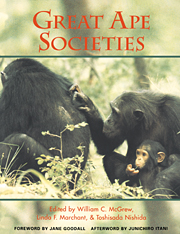Book contents
- Frontmatter
- Contents
- List of contributors
- Preface
- Foreword: conserving great apes
- Part I Apes overviewed
- 1 Toward an understanding of the orangutan's social system
- 2 Comparative socio–ecology of gorillas
- 3 Comparative socio–ecology of Pan paniscus
- Part II Social ecology
- Part III Social relations
- Part IV Minds
- Part V Apes compared
- Part VI Modeling ourselves
- Afterword: a new milestone in great ape research
- Appendix: great ape study sites
- Index
3 - Comparative socio–ecology of Pan paniscus
Published online by Cambridge University Press: 04 August 2010
- Frontmatter
- Contents
- List of contributors
- Preface
- Foreword: conserving great apes
- Part I Apes overviewed
- 1 Toward an understanding of the orangutan's social system
- 2 Comparative socio–ecology of gorillas
- 3 Comparative socio–ecology of Pan paniscus
- Part II Social ecology
- Part III Social relations
- Part IV Minds
- Part V Apes compared
- Part VI Modeling ourselves
- Afterword: a new milestone in great ape research
- Appendix: great ape study sites
- Index
Summary
INTRODUCTION
Pan paniscus, the pygmy chimpanzee or bonobo, has been studied at a number of sites in Zaïre including Lomako, Wamba, Ikela, and briefly at Yalosidi and Lake Tumba. Lake Tumba (Horn, 1980) is a swampy habitat that is visited by pygmy chimpanzees only seasonally. Studies in the mosaic of undisturbed, disturbed and swamp forest of Yalosidi (Kano, 1983; Uehara, 1988, 1990) and at Ikela in the Lilungu region (Sabater Pi et al., 1993) have yet to yield detailed results on socio-ecology. In contrast, investigations at Lomako Forest (Badrian & Badrian, 1984; Badrian & Malenky, 1984; Thompson-Handler et al., 1984; White, 1986, 1988, 1989a, 1989b, 1992a, 1992b; Malenky, 1990; Thompson-Handler, 1990; White and Burgman, 1990; White & Lanjouw, 1992; Hohmann & Fruth, 1993, 1994; Fruth & Hohmann, 1994, Chapter 17) and at Wamba (Kuroda, 1979, 1980, 1984; Kano, 1980, 1982, Chapter 10; Kitamura, 1983; Kano & Mulavwa, 1984; Furuichi, 1987, 1989, 1992; Idani, 1990, 1991; Ihobe, 1992a, 1992b) have both spanned several years and have provided much of the information currently available on the behavior of the pygmy chimpanzee, so that most of the comparisons presented here concentrate on the differences and similarities between the Lomako and Wamba study populations. There are differences in methods used and in the type of information available from each site. Provisioning at Wamba has facilitated habituation, so that more detailed behavioral data collection is possible.
- Type
- Chapter
- Information
- Great Ape Societies , pp. 29 - 42Publisher: Cambridge University PressPrint publication year: 1996
- 43
- Cited by

